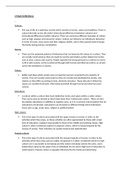4 Mark Definitions:
Culture:
The way of life of a particular society which consists of norms, values and traditions. There is
cultural diversity across the world: intercultural differences (between cultures) and
intracultural differences (within cultures). There are numerous different examples of culture
such as high, popular and consumer culture. Culture can influence an individual’s behaviour
in terms of music, dress sense and their religious beliefs, and is often passed down through
the family during primary socialisation.
Norms:
These are the expected patterns of behaviour that are based on the values of a culture. They
are socially constructed as they are made by society and relative as they depend on factors
such as time, culture and country. People typically feel strong pressure to conform to norms
to fit in with society, as this is enforced through both formal and informal control, as carried
out by the institutions in society.
Values:
Beliefs and ideas which society sees as important and are accepted by the majority of
society. They are socially constructed as they are created and developed by society, and
relative as they differ according to time, ethnicity and place. Those who don’t follow the
values are considered deviant, often being punished through formal and informal social
control.
Subculture:
A culture within a culture that share distinctive norms and values within a wider culture.
They can be seen as deviant as they break away from ‘mainstream culture’. There can also
be positive subcultures in addition to negative ones, as it is a common misconception that all
subcultures are deviant. Subcultures can be based on different things which individuals
share such as age, music taste, religion or political beliefs.
High culture:
This is the type of culture associated with the upper classes in society. It refers to the
activities which they enjoy, as these activities are often appreciated by those with a high
level of education, making it inaccessible to those in the middle and working classes. High
culture is often considered superior to popular culture, which is instead enjoyed by the
masses of society. Their activities are usually classical and sophisticated.
Popular culture:
This is the type of culture associated with the masses/majority of society. It refers to the
activities which they enjoy and are widely recognised. It is often considered inferior to high
culture as it is accessible to everybody and this makes everybody almost the same, and is
looked down upon by the upper class as individuals do not need a high level of education to
understand it. Popular culture is arguably influenced by the media and advertising.
, Global culture:
The growing trend of cultural products and activities becoming ‘universal’ as they are spread
worldwide, through the process of globalisation, where technology has allowed for different
cultures to spread across the internet. This causes cultures to lose their distinctiveness
through the process of cultural hybridity as the world is becoming a smaller place. McLuhan
described this as a ‘global village’.
Consumer culture:
This is when society portrays a sense of identity and status through the purchase of
consumer goods, due to a constant pressure to keep up with trends in society. Some
examples would be branded clothing, phones and cars. This has been made possible due to
the increasing availability of goods and credit, making consumption a leisure pursuit.
Consumer culture is also influenced by globalisation whereby the world is becoming a
smaller place, and individuals across the world feed into a consumer culture.
Cultural diversity:
Diversity refers to variety or difference. Cultural diversity is the difference found in societies
as according to one’s norms, values and traditions. There are two types of cultural diversity:
intercultural (between cultures) and intracultural (within cultures). This contrasts to cultural
hybridity and homogenisation, where cultural groups are merging and losing their
distinctiveness, in a world characterised by globalisation.
Cultural hybridity:
A hybrid is the merging of two or more things. Cultural hybridity refers to the merging of
cultures. An example would be UK culture as it includes aspects of Asian, US and Caribbean
culture. Cultural hybridity is usually evident in food, music and fashion. It can be argued that
cultural hybridity has increased in society due to the rise in globalisation and technology, as
people are now able to access other cultures more easily.
Primary socialisation:
This is the first stage of socialisation in which an individual learns the norms and values of a
society. This occurs from birth to the age of five and it is known as the critical period. The
child will learn language and basic behaviour patterns to fit in. The agency of socialisation
involved in this is the family. This is done through the processes of informal and formal social
control, where individuals are rewarded and sanctioned for particular behaviours.
Secondary socialisation:
This is the second stage of socialisation in which an individual consolidates their norms and
values as well as developing their identity. It occurs from childhood to adulthood,
consistently through our lives. The agencies of socialisation involved include the peer group,
the school, the workplace, religion and the media. This is done through the processes of
informal and formal social control, where individuals are rewarded and sanctioned for
particular behaviours.




